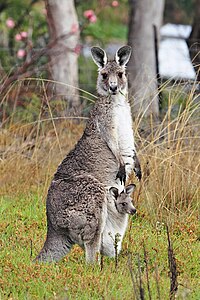
A kangaroo is a marsupial from the family Macropodidae (macropods, meaning 'large foot'). In common use the term is used to describe the largest species from this family, especially those of the genus Macropus, Red Kangaroo, Antilopine Kangaroo, Eastern Grey Kangaroo andWestern Grey Kangaroo. Kangaroos are endemic to the country of Australia. The smaller macropods are found in Australia and New Guinea.
Larger kangaroos have adapted much better to changes brought to the Australian landscape by humans and though many of their smaller cousins are endangered, they are plentiful. They are not farmed to any extent, but wild kangaroos are shot for meat, leather hides, sport, and to protect grazing land for sheep and cattle. Although there is some controversy, harvestingkangaroo meat has many environmental and health benefits over traditional meats.
The kangaroo is a national symbol of Australia: its emblem is used on the Australian coat of arms, on some of its currency, as well as by some of Australia's best known organisations, including Qantas. The kangaroo is important to both Australian culture and the national image and consequently there are numerous popular culture references
Description
There are four species that are commonly referred to as kangaroos:
- The Red Kangaroo (Macropus rufus) is the largest surviving marsupial anywhere in the world. Fewer in numbers, the Red Kangaroo occupies the arid and semi-arid centre of the country. A large male can be 2 metres (6 ft 7 in) tall and weigh 90 kg (200 lb).[14]
- The Eastern Grey Kangaroo (Macropus giganteus) is less well-known than the red (outside of Australia), but the most often seen, as its range covers the fertile eastern part of the country.
- The Western Grey Kangaroo (Macropus fuliginosus) is slightly smaller again at about 54 kg (119 lb) for a large male. It is found in the southern part of Western Australia, South Australia near the coast, and the Darling River basin.
- The Antilopine Kangaroo (Macropus antilopinus) is, essentially, the far-northern equivalent of the Eastern and Western Grey Kangaroos. Like them, it is a creature of the grassy plains and woodlands, and gregarious.
In addition, there are about 50 smaller macropods closely related to the kangaroo in the family Macropodidae.
Europeans have long regarded kangaroos as strange animals. Early explorers described them as creatures that had heads like deer (without antlers), stood upright like men, and hopped like frogs. Combined with the two-headed appearance of a mother kangaroo, this led many back home to dismiss them as travellers' tales for quite some time.[citation needed] The first kangaroo to be exhibited in the western world was an example shot by John Gore, an officer on Captain Cook's Endeavour in 1770.[15][16] The animal was shot and its skin and skull transported back to England whereupon it was stuffed (by taxidermists who had never seen the animal before) and displayed to the general public as a curiosity.
Kangaroos have large, powerful hind legs, large feet adapted for leaping, a long muscular tailfor balance, and a small head. Like all marsupials, female kangaroos have a pouch called a marsupium in which joeys complete postnatal development
Behaviour
Kangaroos are the only large animals to use hopping as a means of locomotion. The comfortable hopping speed for Red Kangaroo is about 20–25 km/h (13–16 mph), but speeds of up to 70 km/h (44 mph) can be attained, over short distances, while it can sustain a speed of 40 km/h (25 mph) for nearly 2 kilometres (1.2 mi). This fast and energy-efficient method of travel has evolved because of the need to regularly cover large distances in search of food and water, rather than the need to escape predators. To move at slow speeds, it uses its tail to form a tripod with its two forelimbs it then raises its hind feet forward.
The average lifespan of kangaroos averages at 6 years in the wild to in excess of 20 years in captivity, varying by species. Most individuals, however, do not reach maturity in the wild
No comments:
Post a Comment